August 28, 2017
Guest Poem Describes Buckhorn as “Sanctuary”
We are fortunate indeed to host many creative, talented guests who create a poem and or other artwork inspired by their surroundings
. One of those is Charleen M. VonderMeulen. Charleen and her group of friends are regular visitors to the Buckhorn Inn. She crafted this lovely poem during her visit earlier this month. Her friends agree that it captures their experience here perfectly! Thanks so much for giving us permission to share your work, Charleen. Our favorite phrase is “takes our hand and trades it for a heart”–that will stay with us for a long, long time.
Mountain Sanctuary
This mountain sanctuary lights us up,
Engulfed with its love.
We meet as strangers, but seem guided from above.
There seems to be a wonder that leads us to a friend;
That takes our hand and trades it for a heart
And binds us into friendships we hope will never part.
Eclipsed by some Eternal Strength, no sun can ever dim.
We leave enwrapped–hugged–with this loving mist within.
Resources for Poet and Poem
Love poetry? So do we! One of our favorite resources is the Poetry Foundation http://www.poetryfoundation.org. This organization provides public programs and live events. They maintain a source of online access to Poetry magazine content–more than 100 years worth! They also have an easy-t0-access online archive of poet features, poems, and educational resources. Their awards and fellowships are designed to foster poets at all stages of their careers.
According to Writers’ Digest, there are more than 50 distinct types of poems. From abstract to epitaphs to free verse to sonnets, there is a style for nearly every taste. The emphasis on the aesthetics of language is one feature that delineates poetry from prose. Poets use metaphors, similes and other techniques to express emotion and open up a new world for their readers. Thank you again, Charleen, for taking us with you on this journey.
August 21, 2017
Buckhorn Neighbors: Buie Pottery
One of the oft-asked questions from our guests is where we got the charming little pottery lamps on our tables in the dining room.
These lamps were created by one of our neighbors in the Great Smoky Arts and Crafts Community, Buie Pottery. Buie began throwing pottery when she was only 17 and has been enjoying “slinging mud” every since! She earned a Bachelor of Fine Arts Degree from the University of Tennessee. She opened her studio and gallery in 1986. Her stoneware pieces are colorful, functional, and very attractive. http://www.buiepottery.com
A Primer on Pottery
It is one of the oldest human art forms. Some pieces have been identified as being from the pre-Neolithic period. Ancient vessels and figurines have been recovered from all over the world: China, Russia, Japan, Sub Saharan Africa, and South America. Pottery is durable, so shards and pieces have survived long after other materials have broken down. By examining these objects, archeologists learn much about the daily life of a particular culture.
Creating Pottery
Before the objects are formed, the clay must be kneaded to ensure that water is evenly distributed throughout the object. Then air trapped within the clay is removed. Then objects are formed from the prepared clay by hand-forming or by throwing on a potter’s wheel. The clay can also be molded or machine-shaped. The object is then heated to high temperatures in a kiln to remove the water. The resulting object is hard and strong.
Pieces may be decorated before, or after, firing. Some of the main means of decoration are painting, glazing or carving. Colored clays or other additives may be worked into the clay to create different textures and effects.
Watching a potter at work is fascinating. We encourage you to stop by one of the local artisan studios on the Arts & Crafts Loop the next time you visit us.
August 14, 2017
Buckhorn Neighbors: The Brown Farm and Its Bison Herd
I first became fascinated by bison when, as a child, I read Robert McClung’s 1960 book Shag, Last of the Plains Buffalo. The story of the magnificent beast’s struggle against drought, famine, and hunters made a lasting impact on me. Imagine my delight to realize that a herd resides only a little more than a mile from the Buckhorn Inn!
Locals know Benny Hammonds as the longtime Gatlinburg-Pittman high school football coach. In 2013 he purchased 3 bison cows and one bull. A recent birth puts the size of the herd at seven now. To visit The Brown Farm, turn right onto Buckhorn Road from Tudor Mountain Road. Drive a little more than a mile (the road turns into #454) and you will see the farm on the left. There is no admission charge and there is parking. Be careful–the fence is electrified.
Status of American Bison
The American Bison (also sometimes called American Buffalo) is the largest surviving land animal in North America. During the 19th and 20th centuries the creatures were hunted nearly to extinction. An estimated 50 million bison were slaughtered for sport. They are no longer listed as endangered, but their future is not assured. According to the National Bison Association, http://www.bisoncentral.com, it is mainly through the efforts of small farmers, like Mr. Hammonds, that the animals are being preserved.
They may appear peaceful and nonchalant, but bison can charge without warning. Both males and females have horns and can use their massive heads as battering rams. They can gallop at speeds near 35 mph and typically weigh around 2,000 pounds, so you can imagine the momentum they can establish.
They are herbivores and prefer to eat grass and sometimes sedges. Early mornings and evenings are often the best times to see them be active. They rest during the day and graze during the morning and evening hours.
They like to roll in depressions in the dirt–a behavior called “wallowing”. Wallowing may help them cope with biting insects and to self-regulate their body temperatures.
We hope you get a chance to visit these magnificent creatures.
August 6, 2017
Pitching Horseshoes at Buckhorn Inn
The Buckhorn Inn’s pits for pitching horseshoes are located near stop 18 on our Nature Trail. This is the stop near the glider and St. Cordelia’s Garden. What a great way to while away an afternoon!
History of Horseshoes
Many experts believe that the origins of the game lie in ancient Greece. Citizens of less affluence could not afford a discus for sport. Therefore they used horseshoes, sometimes weighing up to four pounds. At this point, this was a distance game. Players competed to see how far they could throw. At some point, perhaps several centuries AD, the game evolved into one of accuracy. The use of poles or spikes as targets
became popular and the game spread around the world. Pitching shoes was a favorite pastime of soldiers and when they returned home they introduced the activity to their communities. Following the Revolutionary War, England’s Duke of Wellington said “The War was won by pitchers of horse hardware.” In 1869 England created very exacting rules for the game. The first worldwide horseshoe tournament was held in 1910 in Kansas. The winner received a belt with horseshoes affixed to it. Let’s hope he didn’t tumble into a large body of water wearing such a heavy trophy! In 1914, the game became more formalized. The “Horseshoe Guide” provided rules on scoring, stake height, shoe weight, size of pitchers’ box, and the distance between stakes.
Horseshoes Today
Since 1926 the governing body of the sport has been the National Horseshoe Pitchers Association of America http://www.horseshoepitching.com. It is estimated that there are more than 15 million horseshoe enthusiasts in the United States and Canada. To score in this game, you either must throw the shoe around the stake, or throw the shoe closer to the stake than does your opponent. This scoring system led to the saying “close only counts in horseshoes and hand grenades”!
We hope to see you trying your pitching the next time you visit us at the Buckhorn Inn!



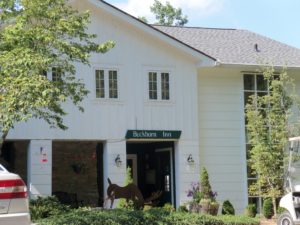
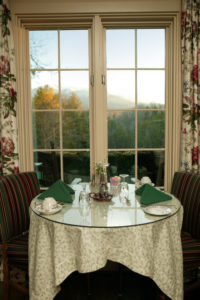
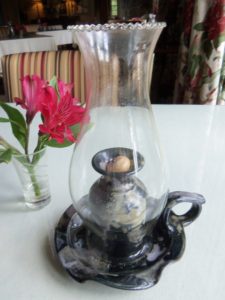
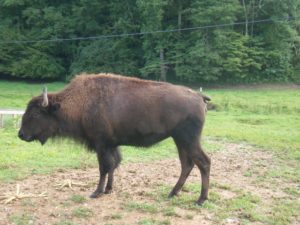
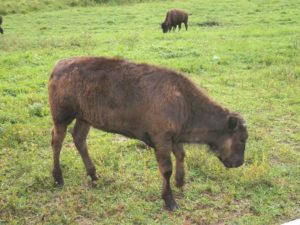
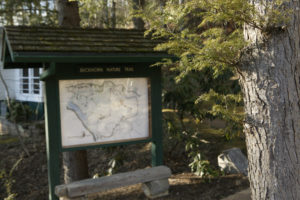
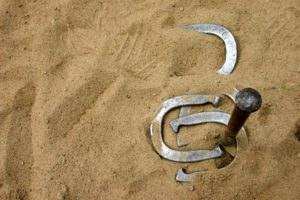

Gatlinburg Weather
Click for weather forecast